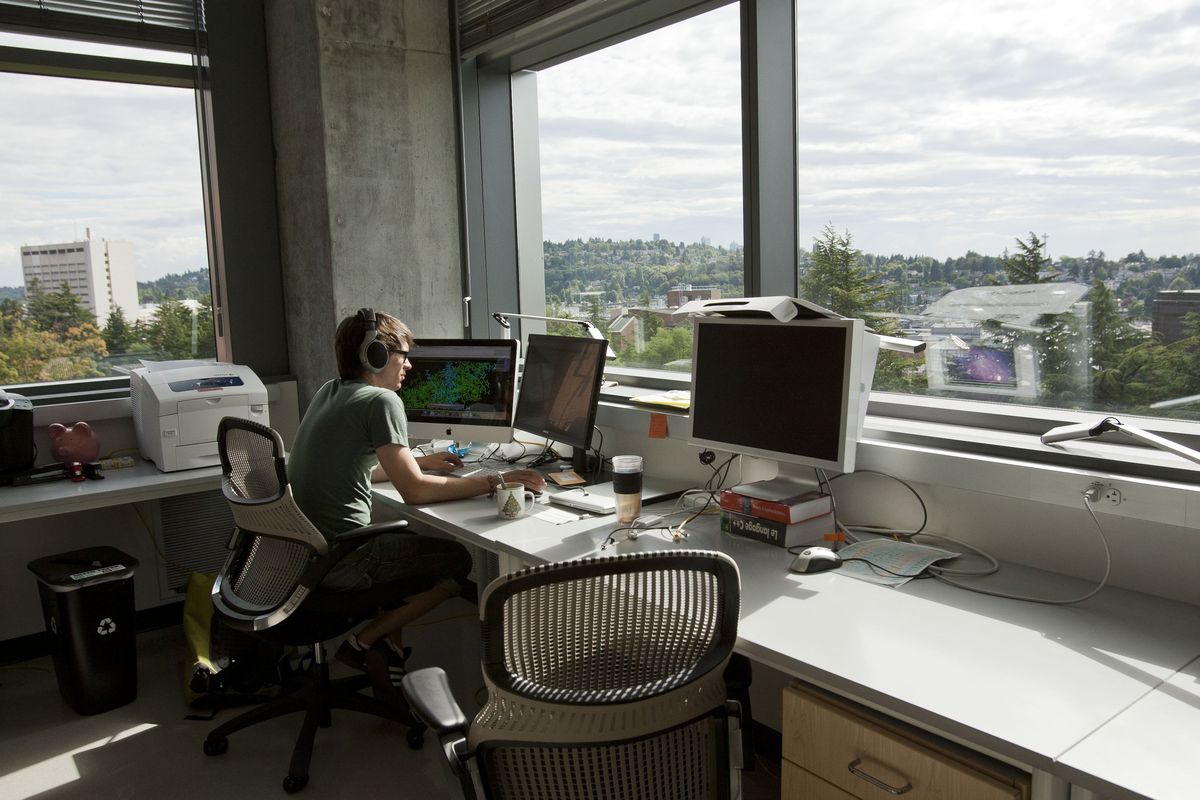Cutting-edge building at UW ready for cutting-edge work

SEATTLE – As a building, the University of Washington’s new molecular engineering lab is interesting in its own right – designed with cutting-edge features to make it energy efficient, and bright lab spaces with killer views of Mount Rainier and the Olympics.
But what really marks the newest building on the UW campus is the work going on inside, where scientists are designing proteins that could one day cure diseases, and clean technology materials that could make it easier to convert solar energy into electricity.
For some of this work, researchers are even getting help from an unlikely source: thousands of nonscientists around the world who play an online game to create new proteins for disease detection and treatment.
The four-story, $77 million Molecular Engineering & Sciences building opened this month, just south of Gerberding Hall. And unlike old labs of the past, which tended to be dark and isolating, this one is filled with sunlight and designed with collaborative spaces for scientists to work together across a range of disciplines.
It’s home to the newly formed Molecular Engineering & Sciences Institute, which, rather than doing purely academic research, is aiming for discoveries that can lead to new technologies and new medicines.
“We want to try to do something really big,” said Pat Stayton, professor of bioengineering and director of the institute. “We hope to generate a lot of knowledge.”
Some examples?
A nano-crystal ink for printable solar cells.
Proteins that could block viruses such as Ebola, HIV, the flu.
And more accurate diagnostic tests for a wide range of health problems.
Molecular engineering involves designing new materials and proteins at the molecular level, and the UW is one of the leaders in the field, Stayton said. The institute is focusing on two areas: clean energy and biotechnology.
In the building, each floor is divided down the middle, with office space on one side and lab space on the other. And it’s also designed to be energy efficient, with gels in the wall that moderate temperatures and solar chimneys that vent the air inside. There’s a living roof planted with sedums on one level, and a rain garden to absorb runoff outside the building.
The basement floor was built with an extra-thick slab, making it one of the biggest vibration-free labs on the West Coast, said Tim Williams, an associate partner with ZGF Architects, which designed the building. It’s filled with a range of high-tech instruments, including powerful lasers, that can make extremely precise measurements at the molecular level.
Fall quarter doesn’t start until the end of September, but last month the building’s fourth-floor labs were already a beehive of activity.
Biochemistry professor David Baker gestured to researchers lined up in a row of desks, working on computers to design proteins that could help treat Ebola, Hodgkin Lymphoma and AIDS.
Proteins are miniature machines that carry out functions in living things, and, “the idea is if we can understand the rules for how they work, we could make proteins that solve new problems,” he said.
Because of new developments in genetics, the UW researchers can design and test 400 different proteins every month, Baker said. The UW works with a Massachusetts company, Gen9, that has come up with a process to make genes on a very large scale.
Once a researcher has designed a protein that looks promising, “we fill out an order form for the gene on the Web,” Baker said. “It’s crazy. Then the genes come in, and we put them in bacteria and make the proteins. Then we see what they do.”
Of those 400 proteins being investigated each month, about 25 to 50 a month are inspired by an unusual source: Online gamers playing Foldit, a free protein-folding game (www.fold.it), that was developed in collaboration between the UW’s molecular biology department and the UW’s Center for Game Science, Baker said.
About 230,000 players worldwide have downloaded the game, and use intuition and spatial reasoning to try to design proteins with stable, efficient designs.
Another contribution to unraveling protein structures comes from the more than 300,000 people who have downloaded a UW-designed program – Rosetta@home – which works kind of like a screen saver, taking advantage of processing time on idle computers. It, too, tries to work out the three-dimensional profile of proteins.
Molecular engineering has its critics. Some environmental groups have called for greater regulation and oversight of the technology, also known as nanotechnology, because of concerns that nanoparticles could cause unknown health problems.
To that end, the UW is part of a consortium funded by the National Institutes of Health that is looking at safety and toxicology issues, said Francois Baneyx, director of the UW’s Center for Nanotechnology, which is part of the molecular engineering institute. The UW researchers themselves are working with such small quantities of the new materials that health concerns are not a factor, “But any material that will be really scaled up and made in the market in large quantities will have to be evaluated for its toxicology profile,” Baneyx said.